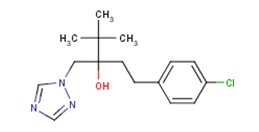Tebuconazole
-
Post Date:
Nov 04,2013 -
Expiry Date:
May 03,2014 -
Detailed Description:
Cas No. :107534-96-3TECHNICAL --- FUNGICIDE: Tebuconazole
 CAS No.: 107534-96-3
CAS No.: 107534-96-3
Content: 95%TCNOMENCLATURE
Common name:
tebuconazole (BSI, draft E-ISO)
IUPAC name:
(RS)-1-p-chlorophenyl-4,4-dimethyl-3-(1H-1,2,4-triazol-1-ylmethyl)pentan-3-ol
Chemical Abstracts name:
(?-α-[2-(4-chlorophenyl)ethyl]-α-(1,1-dimethylethyl)-1H-1,2,4-triazole-1-ethanol
Other names fenetrazole*; terbuconazole*; terbutrazole*; ethyltrianol*
CAS RN: [107534-96-3]
EEC no.: ELINCS: 403-640-2PHYSICAL CHEMISTRY
Composition: Racemate
Mol. wt.: 307.8
M.f.: C16H22ClN3O
Form: Colourless crystals; (tech., colourless to light brown powder).
M.p.: 105 ℃
V.p.: 1.710-3 mPa (20 ℃) (OECD 104)
KOW: logP = 3.7 (20 ℃)
Henry: 110-5 Pa m3 mol-1 (20 ℃)
S.g./density: 1.25 (26 ℃)
Solubility: In water 36 mg/l (pH 5-9, 20 ℃). In dichloromethane >200, isopropanol, toluene 50-100, hexane <0.1 (all in g/l, 20 ℃)
Stability: Stable to elevated temperatures, and to photolysis and hydrolysis in pure water, under sterile conditions; hydrolysis DT50 >1 y (pH 4-9, 22 ℃). See also Environmental Fate.APPLICATIONS
Biochemistry: Steroid demethylation (ergosterol biosynthesis) inhibitor.
Mode of action: Systemic fungicide with protective, curative, and eradicant action. Rapidly absorbed into the vegetative parts of the plant, with translocation principally acropetally.
Uses: As a seed dressing, tebuconazole is effective against various smut and bunt diseases of cereals such as Tilletia spp., Ustilago spp., and Urocystis spp., also against Septoria nodorum (seed-borne), at 1-3 g/dt seed; and Sphacelotheca reiliana in maize, at 7.5 g/dt seed. As a spray, tebuconazole controls numerous pathogens in various crops including: rust species (Puccinia spp.) at 125-250 g/ha, powdery mildew (Erysiphe graminis) at 200-250 g/ha, scald (Rhynchosporium secalis) at 200-312 g/ha, Septoria spp. at 200-250 g/ha, Pyrenophora spp. at 200-312 g/ha, Cochliobolus sativus at 150-200 g/ha, and head scab (Fusarium spp.) at 188-250 g/ha, in cereals; leaf spots (Mycosphaerella spp.) at 125-250 g/ha, leaf rust (Puccinia arachidis) at 125 g/ha, and Sclerotium rolfsii at 200-250 g/ha, in peanuts; black leaf streak (Mycosphaerella fijiensis) at 100 g/ha, in bananas; stem rot (Sclerotinia sclerotiorum) at 250-375 g/ha, Alternaria spp. at 150-250 g/ha, stem canker (Leptosphaeria maculans) at 250 g/ha, and Pyrenopeziza brassicae at 125-250 g/ha, in oilseed rape; blister blight (Exobasidium vexans) at 25 g/ha, in tea; Phakopsora pachyrhizi at 100-150 g/ha, in soya beans; Monilinia spp. at 12.5-18.8 g/100 l, powdery mildew (Podosphaera leucotricha) at 10.0-12.5 g/100 l, Sphaerotheca pannosa at 12.5-18.8 g/100 l, scab (Venturia spp.) at 7.5-10.0 g/100 l, white rot in apples (Botryosphaeria dothidea) at 25 g/100 l, in pome and stone fruit; powdery mildew (Uncinula necator) at 100 g/ha, in grapevines; rust (Hemileia vastatrix) at 125-250 g/ha, berry spot disease (Cercospora coffeicola) at 188-250 g/ha, and American leaf disease (Mycena citricolor) at 125-188 g/ha, in coffee; white rot (Sclerotium cepivorum) at 250-375 g/ha, and purple blotch (Alternaria porri) at 125-250 g/ha, in bulb vegetables; leaf spot (Phaeoisariopsis griseola) at 250 g/ha, in beans; early blight (Alternaria solani) at 150-200 g/ha, in tomatoes and potatoes.
Phytotoxicity: Good plant compatibility in most crops with any formulation, and achieved in more sensitive crops by appropriate formulations, e.g. WP, WG or SC. -
CAS Registry Number:
107534-96-3 -
Synonyms:
;1,2,4-Triazole-1-ethanol, alpha-(2-(4-chlorophenyl)ethyl)-alpha-(1,1-dimethylethyl)-, (+-),;alpha-(2-(4-chlorophenyl)ethyl)-alpha-(1,1-dimethylethyl)-1H-1,2,4-triazol-1-ethanol, (+-)-;Elite;Folicur;Folicur 1.2 EC;GWG 1609;HWG 1608;Lynx;LYNX 1.2;Raxil;1-(4-chlorphenyl)-4,4-dimethyl-3-(1H-1,2,4-triazole-1-methyl)amyl-3-alcohol;Horizon;(RS)-1-(4-chlorophenyl)-4,4-dimethyl-3-(,2,4-triazol-1-yl)-1-3-ol;(RS)-1-p-chlorophenyl-4,4-dimethyl-3-(1H-1,2,4-triazol-1-ylmethyl)pentan-3-ol;Tebuconazol;1-(4-Chlorophenyl)-4,4-dimethyl-3-(1,2,4-triazole-1-yl-methyl)pentane-3-ol;Lynx Raxil;Silvacur;(RS)-1 -(4-chlorophenyl)-4,4-dimethyl-3-(1H-1,2,4-triazol-l-ylmethyl)pentan-3-ol;(+/-)-alpha-(2-(4-chlorophenyl)ethyl)-alpha-(1,1-dimethylethyl)-1H-1,2,4-triazol-1-ethanol;1-(4-chlorophenyl)-4,4-dimethyl-3-(1H-1,2,4-triazol-1-ylmethyl)pentan-3-ol;2-[2-(4-chlorophenyl)ethyl]-3,3-dimethyl-2-(1H-1,2,4-triazol-1-yl)butan-1-ol; -
Molecular Formula:
C16H22ClN3O -
Molecular Weight:
307.8184 -
Molecular Structure:

-
Hazard Symbols:
Xn:Harmful;
N:Dangerous for the environment;
-
Risk Codes:
R22:;
R51/53:;
R63:;
-
Safety Description:
S2:;
S22:;
S36/37:;
S61:;
-
Company:
Nanjing Essence Fine-chemical Co., Ltd [ China ] -
Contact:
Valerie Zhou -
Tel:
025-86518999-836 -
Fax:
025 -86455985 -
Email:
sales@essencechem.com